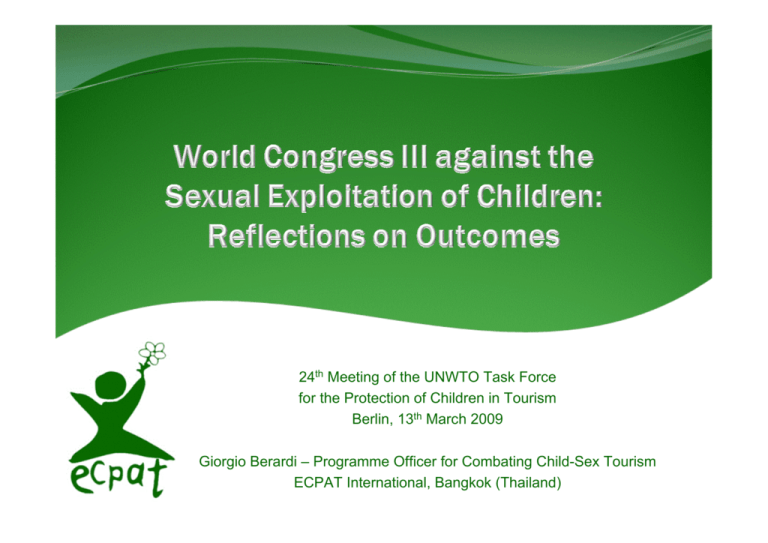Presentation to the Body Shop
advertisement

24th Meeting of the UNWTO Task Force for the Protection of Children in Tourism Berlin, 13th March 2009 Giorgio Berardi – Programme Officer for Combating Child-Sex Tourism ECPAT International, Bangkok (Thailand) CHILD-SEX TOURISM Child-sex tourism (CST) is the sexual exploitation of children by a person or persons who travel from their home district, home geographical region, or home country and then engage in sexual contact with children. Child-sex tourists can be domestic travellers or they can be international tourists. CST often involves the use of accommodation, transportation and other tourism-related services that facilitate contact with children and enable the perpetrator to remain fairly inconspicuous in the surrounding population and environment. WC3 – QUICK FIGURES 137 participating governments Ca. 3500 participants from 170 countries 300 children and adolescents 5 themes 227 workshops, panels and dialogues CONGRESS THEMES New dimensions of Commercial Sexual Exploitation of Children Legal framework and enforcement Integrated inter-sectoral policies Role of the private Sector and corporate social responsibility Strategies for international co-operation THIS PRESENTATION Pre-Congress thematic paper Findings World Congress CST-specific recommendations World Congress general recommendations Overall future implications Findings and recommendations from the thematic paper on CST Increased ease of travel to farther (and remoter) destinations and different channels used by perpetrators Destinations emerging often without proper planning Sustainability of measures and initiatives Findings and recommendations from the thematic paper on CST Private-sector engagement to be intensified Enhanced awareness-raising and need for value shift Overarching need for concerted efforts and responses WC3 MAIN RECOMMENDATIONS Criminalisation of all forms of sexual exploitation of children Attention towards all forms of corruption Addressing the side of demand Closer engagement of local communities WC3 MAIN RECOMMENDATIONS (continued) Comprehensive, co-ordinated support to child victims Creation of focal points for children’s issues Stronger engagement of the private sector Effective system of extra-territorial legislation Institutional collaboration Interventions are still often isolated and disconnected There is definitely room for more institutional cooperation (governments, law enforcement, civil society) in order to lay the foundations for better responses to child-sex tourism. Information exchange The interagency and cross-border flow of information is not yet effectively helping combat CST Co-operation should be facilitated between the agencies involved by way of preventive exchange of information regarding, for example, travelling convicted sex offenders, as well as in the field of cross-border investigations to prepare cases under extra-territorial legislation. Tourism development The development of tourist facilities and resorts is primarily a financial cost-benefit exercise Tourism development should be tackled more holistically and include proactive collaboration with the private sector aiming at child protection. Training and employment The attraction of tourism resorts is often not matched by suitable opportunities for more vulnerable categories Provision of adequate training and employment opportunities – in tourism settings and with support from the industry – for adolescents above the minimum working age. Codes of Conduct CSR initiatives still too sparse and insufficient Private-sector engagement to be strengthened by the adoption of reliable, standardised tools for social responsibility. Enhanced awareness-raising Child-sex tourists are often moving away from strictly tourism-related channels and facilities Broader awareness-raising aimed at non-tourism structures/entities – and the public at large – through all available media. Overall implications for future action Systemic/holistic approach to programmes Enhanced collaboration across borders Institutionalised collaboration among agencies Community involvement and engagement Sharing of information and co-ordination of responses Private sector as a key player in addressing the issue Thank you for your kind attention






